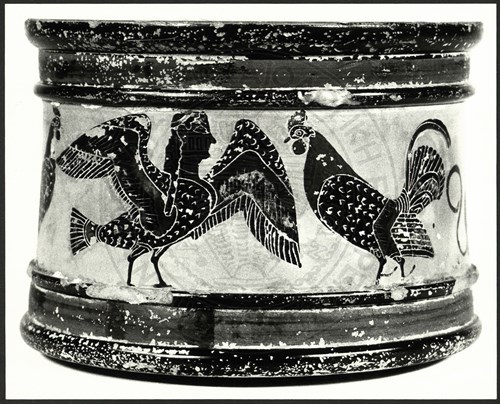After arriving in Eleusis, the prospective mystai engaged in fasting, purification, and sacrifices in the morning. They abstained from eating in remembrance and imitation of Demeter's fasting while looking for her daughter. According to the Neoplatonic philosopher Porphyry, the mystai were forbidden to eat red mullet, saddled seabream, dogfish, and domestic birds (especially the rooster, a sacred animal of Persephone), broad beans, apples, pomegranates, eggs, and meat that was not properly slaughtered. Most of these delicacies were generally forbidden in the mystical cults, as was the wine from which the mystai also abstained (as Demeter had refused to consume wine when Metaneira offered it to her). The first day in Eleusis could have passed with a complete fast, which would culminate in the consumption of kykeon, the drink prepared by or offered to the goddess in the palace of Celeus (a mixture of barley flour, water, and pennyroyal).

Pyre Γ. Pyxis without lid [siren?], Konstantina Kokkou-Vyridi, photograph, Εν Αθήναις Αρχαιολογική Εταιρεία © Η εν Αθήναις Αρχαιολογική Εταιρεία
On the first day in Eleusis, the initiates offered another sacrifice in honour of Demeter, Persephone, and the other Eleusinian gods under the supervision of the Archon Basileus, the paredroi, and the epoptai (as in Athens). Perhaps the goddesses received the pelanos (leavened bread of barley and wheat that had been harvested in the sacred Rharian field). The Eumolpidae determined the number of pelanos offered to each deity. An impressive part of the celebrations must have been the ox sacrifice offered by the Athenian ephebes. In a show of strength and vigour, the ephebes lifted the ox into the air with their hands and sliced its throat.
The mystai entered the sacred precinct the same night. This was when the real celebration began, but it is also the point where the ancient testimonies cease to offer us detailed information. We know that the mystai experienced something designed to evoke awe, confusion, joy, and bliss. The ritual included three elements (the dromena, legomena, and deiknymena), but we do not know their actual content or the form they took. The dromena were probably representations of the passion of the goddess Demeter that led the mystai to a final “purification”. The legomena may have been a kind of catechism, while the deiknymena included the presentation of the sacred objects by the hierophant bathed in intense light. The initiation was an intense spiritual experience that gave the mystai hope for the afterlife.





